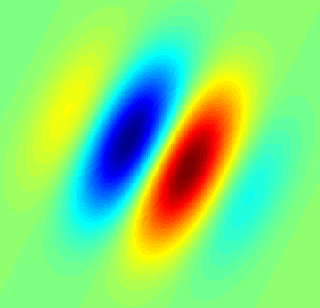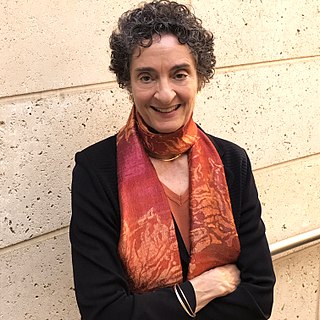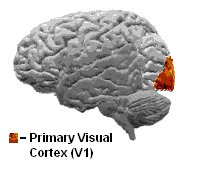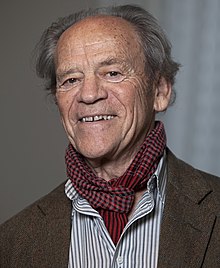
Roger Wolcott Sperry was an American neuropsychologist, neurobiologist, cognitive neuroscientist, and Nobel laureate who, together with David Hunter Hubel and Torsten Nils Wiesel, won the 1981 Nobel Prize in Physiology and Medicine for his work with split-brain research. A Review of General Psychology survey, published in 2002, ranked Sperry as the 44th most cited psychologist of the 20th century.

David Hunter Hubel was an American Canadian neurophysiologist noted for his studies of the structure and function of the visual cortex. He was co-recipient with Torsten Wiesel of the 1981 Nobel Prize in Physiology or Medicine, for their discoveries concerning information processing in the visual system. For much of his career, Hubel worked as the Professor of Neurobiology at Johns Hopkins University and Harvard Medical School. In 1978, Hubel and Wiesel were awarded the Louisa Gross Horwitz Prize from Columbia University. In 1983, Hubel received the Golden Plate Award of the American Academy of Achievement.

A cortical column is a group of neurons forming a cylindrical structure through the cerebral cortex of the brain perpendicular to the cortical surface. The structure was first identified by Mountcastle in 1957. He later identified minicolumns as the basic units of the neocortex which were arranged into columns. Each contains the same types of neurons, connectivity, and firing properties. Columns are also called hypercolumn, macrocolumn, functional column or sometimes cortical module. Neurons within a minicolumn (microcolumn) encode similar features, whereas a hypercolumn "denotes a unit containing a full set of values for any given set of receptive field parameters". A cortical module is defined as either synonymous with a hypercolumn (Mountcastle) or as a tissue block of multiple overlapping hypercolumns.
Vernon Benjamin Mountcastle was an American neurophysiologist and Professor Emeritus of Neuroscience at Johns Hopkins University. He discovered and characterized the columnar organization of the cerebral cortex in the 1950s. This discovery was a turning point in investigations of the cerebral cortex, as nearly all cortical studies of sensory function after Mountcastle's 1957 paper, on the somatosensory cortex, used columnar organization as their basis.

Stephen William Kuffler was a Hungarian-American neurophysiologist. He is often referred to as the "Father of Modern Neuroscience". Kuffler, alongside noted Nobel Laureates Sir John Eccles and Sir Bernard Katz gave research lectures at the University of Sydney, strongly influencing its intellectual environment while working at Sydney Hospital. He founded the Harvard neurobiology department in 1966, and made numerous seminal contributions to our understanding of vision, neural coding, and the neural implementation of behavior. He is known for his research on neuromuscular junctions in frogs, presynaptic inhibition, and the neurotransmitter GABA. In 1972, he was awarded the Louisa Gross Horwitz Prize from Columbia University.
The Ferrier Lecture is a Royal Society lectureship given every three years "on a subject related to the advancement of natural knowledge on the structure and function of the nervous system". It was created in 1928 to honour the memory of Sir David Ferrier, a neurologist who was the first British scientist to electronically stimulate the brain for the purpose of scientific study.

A simple cell in the primary visual cortex is a cell that responds primarily to oriented edges and gratings. These cells were discovered by Torsten Wiesel and David Hubel in the late 1950s.
Complex cells can be found in the primary visual cortex (V1), the secondary visual cortex (V2), and Brodmann area 19 (V3).

Carla J. Shatz is an American neurobiologist and an elected member of the American Academy of Arts and Sciences, the American Philosophical Society, the National Academy of Sciences, and the National Academy of Medicine.

A hypercomplex cell is a type of visual processing neuron in the mammalian cerebral cortex. Initially discovered by David Hubel and Torsten Wiesel in 1965, hypercomplex cells are defined by the property of end-stopping, which is a decrease in firing strength with increasingly larger stimuli. The sensitivity to stimulus length is accompanied by selectivity for the specific orientation, motion, and direction of stimuli. For example, a hypercomplex cell may only respond to a line at 45˚ that travels upward. Elongating the line would result in a proportionately weaker response. Ultimately, hypercomplex cells can provide a means for the brain to visually perceive corners and curves in the environment by identifying the ends of a given stimulus.
Michael Greenberg is an American neuroscientist who specializes in molecular neurobiology. He served as the Chair of the Department of Neurobiology at Harvard Medical School from 2008 to 2022.
Lawrence C. Katz was an American neurobiologist. He was an investigator at the Howard Hughes Medical Institute. His lab was located in Duke University Medical Center, where he was the James B. Duke Professor of Neurobiology.
Feature detection is a process by which the nervous system sorts or filters complex natural stimuli in order to extract behaviorally relevant cues that have a high probability of being associated with important objects or organisms in their environment, as opposed to irrelevant background or noise.
Monocular deprivation is an experimental technique used by neuroscientists to study central nervous system plasticity. Generally, one of an animal's eyes is sutured shut during a period of high cortical plasticity. This manipulation serves as an animal model for amblyopia, a permanent deficit in visual sensation not due to abnormalities in the eye.
David Hubel and Torsten Wiesel discovered that mammalian brains contained specific neural cortical columns which were attuned to specific spatial frequencies, specific colors, specific shapes, specific motions. Thus the brain could be viewed as a collection of tuned filters.

Orientation columns are organized regions of neurons that are excited by visual line stimuli of varying angles. These columns are located in the primary visual cortex (V1) and span multiple cortical layers. The geometry of the orientation columns are arranged in slabs that are perpendicular to the surface of the primary visual cortex.
Robert H. Wurtz is an American neuroscientist working as a NIH Distinguished Scientist and Chief of the Section on Visuomotor Integration at the National Eye Institute. He is a member of the US National Academy of Sciences and the American Academy of Arts and Sciences. He is recognised for developing methods for studying the visual system in 'awake-behaving' primates, a technique now widely used for the study of higher brain functions. He pioneered the study of the neuronal basis of vision and its relation with cognitive functions.

The Department of Neurobiology at Harvard Medical School is located in the Longwood Medical Area of Boston, MA. It is consistently ranked as one of the top programs in Neurobiology and behavior in the world. The Department is part of the Basic Research Program at Harvard Medical School, with research pertaining to development of the nervous system, sensory neuroscience, neurophysiology, and behavior. The Department was founded by Stephen W. Kuffler in 1966, the first department dedicated to Neurobiology in the world. The mission of the Department is “to understand the workings of the brain through basic research and to use that knowledge to work toward preventive and therapeutic methods that alleviate neurological diseases”.
The V1 Saliency Hypothesis, or V1SH is a theory about V1, the primary visual cortex (V1). It proposes that the V1 in primates creates a saliency map of the visual field to guide visual attention or gaze shifts exogenously.

Michael Paul Stryker is an American neuroscientist specializing in studies of how spontaneous neural activity organizes connections in the developing mammalian brain, and for research on the organization, development, and plasticity of the visual system in the ferret and the mouse.











